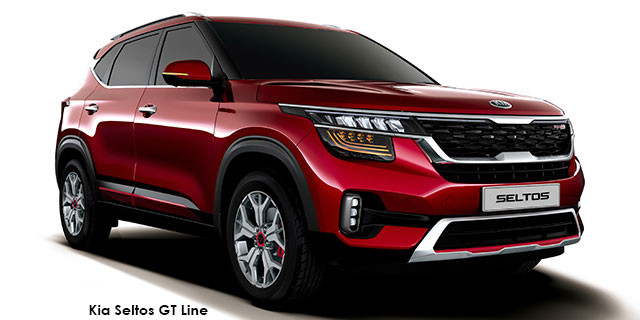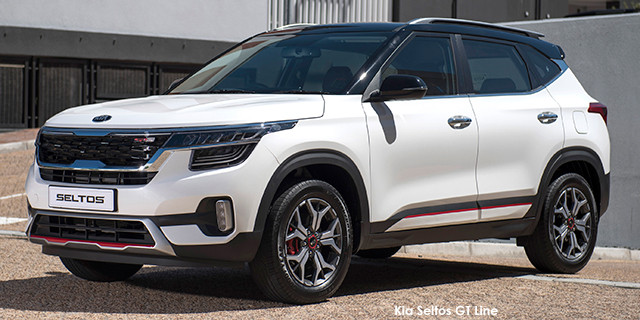
It may be a late arrival on the small-crossover scene but the Kia Seltos is difficult to ignore...
Unlike its relative Hyundai, Kia’s SUV/crossover stable has been sparsely populated by its Sportage and Sorento lines. Now, with the proliferation of small and midsize SUVs and crossovers, Kia has finally decided to climb on the bandwagon with an entry-level offering in the shape of the bold-looking Seltos. But, while it certainly has the cosmetic goods to warrant our attention, it needs to back up those striking looks with some real substance, especially with the likes of the Volkswagen T-Cross and Hyundai Creta snapping up sales at an astonishing rate.
Placing the Seltos in the Kia range is easy enough but its spot in the larger landscape is a little harder to define. It may sit at the first rung of Kia’s crossover/SUV ladder but its dimensions are generally larger than those of its expected rivals. This GT-Line’s price tag, too, sees it rubbing shoulders with competitors from the segment above, such as certain Mazda CX-5 and Hyundai Tucson models.
Kia has a knack for producing some of the more visually appealing cars in their respective segments and it hasn’t skipped a beat with the Seltos. The square nose, imposing grille and headlamp clusters that cut daringly deep into both the bumper and the front wings really grab attention.
The GT-Line cosmetic additions to this purposeful-looking car are hit and miss. There’s a lot of brightwork going on, with chromed finishes adorning the nose, shoulder line and tail. Certain aspects of its application are suitably sporty and no doubt play a role in turning heads but the knurled patina applied to the top of the grille surround is divisive and detracts from one of the car’s best visual elements: those striking LED daytime-running lights that flow into the apex of the signature tiger-nose grille.
It’s a similar story inside, where some neat features are accented with sporty elements to mixed results. Some are delightful; the steel pedal boots and sports seats with contrasting red stitching are particularly pleasing. Others are more of an acquired taste, such as the gloss-black plastic trim adorning the instrument binnacle and mood lighting that can be programmed to pulse to the beat of whatever music you’re playing. Perceived quality is, by and large, good. Barring a smattering of thin-feeling plastics, everything appears well put together and the addition of stitched and padded panels on the facia and doorcards helps move things upmarket.
The Seltos’ interior packaging is nowhere near as divisive, though. Finding a comfy driving position is a cinch with plentiful adjustment on the lightly bolstered front seats and the inclusion of a rake-and-reach-adjustable steering column. Rear legroom is generous. The 256-litre boot is a bit on the small side for a crossover in this bracket but that’s the concession of mounting a full-size spare wheel under the load floor. Drop the rear seatbacks and the Seltos atones for this shortcoming with an impressive 1 072 litres of utility space.
As the halo model, the GT-Line’s standard specification doesn’t want for much with keyless entry and go, automatic full-LED headlamps, touchscreen infotainment system with smartphone integration and electro-chromatically dimming rearview mirror. The omission of features such as climate control and auto wipers is a bit odd given its top billing in the model line.
Korean carmakers’ proclivity for naturally aspirated petrol engines has been a moot point in some of its model lines, with larger cars suffering from a lack of low- to mid-range punch. It’s refreshing to see Kia has opted to go the turbocharged route with its 1,4-litre, four-cylinder Kappa III petrol engine servicing this range-topping GT-Line model. With just 1 282 kg of Seltos to deal with, the 103 kW peak power output is plentiful. Mechanical refinement is also impressive, as even when pushed, the engine doesn’t become boomy or coarse. This does, however, highlight road noise when travelling at motorway speeds. Thankfully, the turbopetrol is fairly frugal and our 100 km test returned a 6,6 L/100 km average consumption.
Of course, it’s that healthy dose of torque which forced induction brings to the party that’s especially welcome. The Kappa III’s 242 N.m spans a broad 1 500 to 3 200 r/min of the rev range, lending it enough in-gear punch to make overtaking manoeuvres fairly effortless. The expected low-end torque benefits aren’t as pronounced as we’d expected, though, and the gearbox is the likely culprit here.
While the 1,4-litre engine was well received, the dual-clutch transmission didn’t meet with the same unanimous praise. The gearshifts are quick and buttery-smooth, but there’s a noticeable pause between throttle input and kick-down from pull-away that takes a little fluidity out of an otherwise pleasant driving experience. It’s especially apparent when the dial on the three-mode drivetrain management system is nudged into eco. This notably dulls throttle response and the subsequent need to lean on the pedal to gain some momentum often sets the engine revving before the transmission hooks second. Opting for sport mode goes some way in addressing off-the-line sluggishness but, again, its willingness to swap cogs at the drop of a hat is welcome when looking to press on. It’s not ideal for leisurely round-town driving, though. These criticisms may sound niggly but that’s only because the transmission is otherwise so smooth and well calibrated.
Once you’ve figured out the transmission’s vagaries, the Seltos begins to impress from behind the wheel. Those handsome 17-inch rims are shod with fairly plump 60-profile rubber, so the ride is a touch firm. That’s about the extent of any negatives regarding the Seltos’ handling. In fact, the electrically assisted steering is well geared and noticeably more communicative and alert than some soggy setups that mar the driving experience in many Korean cars. Brisk directional adjustment will see some body roll but not to a disconcerting degree and the overall driving dynamics are commendably balanced.
TEST SUMMARY
While its 1,4-litre turbopetrol engine is a pleasingly capable unit, we’re not sure if the GT-Line represents the best value for money in the Seltos range, especially as the lower-spec EX and EX+ trims around R50 000 to R90 000 off the asking price – albeit with the less powerful engine – are still reasonably equipped.
That’s not to say the Seltos won’t be warmly met in our market. With its punchy engine, balanced driving manners, bold styling and practical packaging – especially in the context of a marketplace with a seemingly unquenchable thirst for stylish crossovers – the Seltos looks set to make a name for itself.
ROAD TEST SCORE

|

|
Original article from Car
See Full Kia Seltos price and specs here












